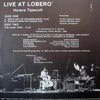



Horace Tapscott - Live At Lobero Vol 2
ORDER LIMITED TO ONE ITEM PER CUSTOMER
Horace Tapscott - piano [click here to see more vinyl featuring Horace Tapscott]
Roberto Miranda – bass
Sonship - percussion
1 LP, standard sleeve
Limited edition
Original analog Master tape : YES
Heavy Press : 180g
Record color : black
Speed : 33 RPM
Size : 12'’
Stereo
Live
Record Press : unspecified
Label : Pure Pleasure Records
Original Label : Nimbus West
Recorded live on Nov. 12, 1981 in the Lobero Theater, Santa Barbara, California
Engineered & mixed by Dennis Moody
Produced by Tom Albach
Remastered by Kevin Gray
Originally released in 1982
Reissued in December 2021
Tracks :
Side A:
- Lino´s Pad
- Close To Freedom
Side B:
- Michael
Reviews :
“While he was not as renowned as most jazz musicians, Horace Tapscott had a definitive impact. As a child, he studied both piano and trombone. In his teenage years, he played with Don Cherry, Frank Morgan, Billy Higgins and Lionel Hampton, mostly on trombone. Eventually, Tapscott focused on the piano. One of his most vital contributions was the creation of the Pan African Peoples Orchestra in 1961. The goal of this ambitious project was to preserve and bring African-American music to audiences everywhere. His muse resulted in two small record labels, Interplay and Nimbus, both of which released his albums. In addition to the Pan African Peoples Arkestra, he recorded as a band leader for over 30 years.
Pure Pleasure Records has released a 180-gram re-mastered vinyl of a notable Tapscott concert, Live At Lobero Vol. 2. Recorded in 1981, it was performed in Santa Barbara and released the same year as Vol. 1. Side A opens with the 13-minute opus, “Lino’s Pad”. Double bassist Robert Miranda establishes a 7 or 8-note repeat vamp. Then drummer Sonship comes in as Tapscott drops a series of double chords. He counters the tight syncopated rhythm with some atmospheric moodiness, featuring right-hand trills. His first solo is skipping and well-paced with touches of halting rhythm. There is a subtle uptick by the trio and then they alternate between that and the original cadence. Miranda switches to bow and alters the feel. The shading is more exotic. Tapscott takes over the basic vamp. Sonship executes a complex extended solo that utilizes the entire drum kit. The next track, “Close To Freedom” is considerably shorter and is arranged in medium swing. It has classic jazz time signatures and a brighter resonance. Miranda’s galloping bass sets up Tapscott’s soulful runs that include some flourishes. His phrasing is excellent and the overall finesse of the group is impressive. A 4-octave fade at the end is very catchy.
Side B consists of one piece, Robert Miranda’s ‘St. Michael”. It is an inspired musical suite that embraces different jazz styles. As it unfolds, Sonship’s ethereal gong is joined by a tone-edgy bowed double bass. Tapscott counters with free-jazz lines that lean on dissonant accents. Eventually Miranda and Sonship get a basic groove established with Tapscott adding some muscular chords. His ability to integrate with his band mates is evident. There is a swing break that morphs gradually into bebop freneticism. Tapscott is not afraid of quieter moments. In a compelling unaccompanied interlude, he brings a hushed ambiance, but amps up the solo with classical trills and wild, crashing modulation. Miranda’s return on bow adds a plaintive touch that shifts to a menacing one. Tapscott complements this with soothing piano. When Sonship rejoins in march-time, there are three separate musical statements integrated simultaneously into the number. A climactic finger-snapping break concludes this satisfying finale.
This vinyl re-mastering of Horace Tapscott – Live At Lobero Vol. 2 is superior. The crowd noise is all but eliminated (The listener is almost startled when there is applause after a solo.). Showcasing lesser-known jazz artists like Tapscott is an essential part of jazz history and Pure Pleasure Records remains one of the leaders in these efforts.” Robbie Gerson, Audiophile Audition, August 2021
This is a reissue of a now out-of-print album from live trio date by the legendary LA-based pianist, composer and multi-bandleader, Horace Tapscott. Pianist Horace Tapscott is always at his best when he is leading a trio. Born in 1934 in Houston, Texas, Horace came from a musical family centered around his mother, Mary Malone Tapscott, who worked professionally as a singer and pianist.
When Horace was nine, the family moved to Los Angeles. As a teenager in the late 1940's, Horace was surrounded by the music of Central Avenue: Art Tatum, Charlie Parker, Coleman Hawkins, Dexter Gordon, were among the many cats on the set. Around this time, Horace also began to take music lessons from teachers Dr. Samuel R. Browne and Lloyd Reese, whose other students included Eric Dolphy and Frank Morgan. Horace's musical studies included trombone in addition to piano.
In 1952, Horace graduated from Jefferson High, got married to Cecilia Payne and went into the Air Force. Horace played in an Air Force Band while he was stationed in Wyoming for his term of duty. After mustering out, he returned to Los Angeles where he worked around on various gigs until he joined the Lionel Hampton Big Band as a trombonist.
In 1959, Horace finally went with the Hampton Big Band to New York, where his friend Eric Dolphy introduced him to John Coltrane. A tough winter, a lack of gigs, and too many nights on the floor of a friend's art gallery finally sent Horace packing for sunny Southern California, where a life with wife and family awaited his return.
The 1960s saw Horace emerge as a die-hard leader of the Avant Garde. Horace began to gain public notice playing with his own group, that included alto saxophonist Arthur Blythe, bassist David Bryant, and drummer Everett Brown II. Horace also appeared on records for the first time.
Horace was always outspoken about racism, politics, stereotypes, and social ethics. His forward-minded vocal presence on and off the microphone is as much a part of his art as his piano playing. As a result, he was labeled a "dissident," categorized as an "employment risk," and black-listed from the music industry establishment in the early 1970s. None of this slowed Horace down. He began gigging sporadically at Parks and Recreation events and for churches around Watts. This "dark period," with his only regular gig at his friend Doug Weston's Troubadour on Los Angeles' "Restaurant Row," was also a time of intense creativity.
Around 1977, Horace reorganized the Pan-Afrikan Peoples Arkestra with the help of several old friends and many new faces. The Arkestra performances involve singing, dancing, and poetry in addition to the music. Soon after the new group's debut, Horace came to the attention of producer Tom Albach who contracted Horace to record a number of albums for Nimbus Records. Albach also helped introduce Horace to an international audience by arranging several European tours.
The '80s saw Horace emerge as one of jazz's premiere solo pianists. He recorded several solo piano albums for Nimbus.
Ratings :
Discogs : 4.83 / 5 ; Audiophile Audition : 4.5 / 5



